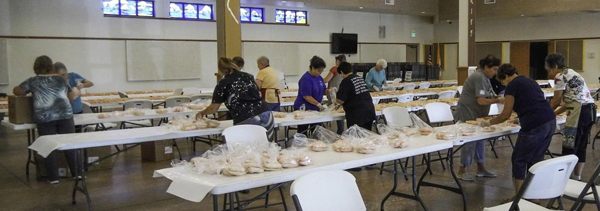Volunteers join forces to bake thousands of ladyfingers for church festival
BY MIKE SPENCE |

Technically, it's not a cookie; it's a biscuit. No matter how you classify it, the ladyfinger has become a staple at functions held at St. Joseph's Catholic Church in Blende.
The ladyfinger has become so popular at St. Joseph's that producing enough to meet demand has turned into a pretty big effort.
Dozens of volunteers -- mostly women but a few men, too --their ages ranging from 8 to 90, spent five days late last month baking, frosting and bagging the ladyfingers for sale at the church's annual festival, which began Friday and concludes Sunday at the church, 1145 S. Aspen Road.
The volunteers gather three other times during the year to make ladyfingers: For a church craft show; for the church's annual spaghetti dinner; and for the annual observance of St. Joseph's Feast.
A tradition
No one is certain when the tradition of making ladyfingers for church events began at St. Joseph's.
"We really don't know," said Anita Spinuzzi, who estimates she's been making the biscuits for more than 40 years. "We didn't keep very good records back then. I know my mom was doing it. She died in 1985. We think it started in the 1960s."
Several women say they have been making the ladyfingers for the church for at least 50 years.
"Usually we have 35 or 40 volunteers a day," said Debbie Genova, who has been part of the effort for at least 30 years. "It's not always the same people. They come when they can come and help out."
Betty Carlino at 83 is one of the oldest volunteers.
"I started making them when I was a teenager and came with my mom to help," she said.
Linda Bartolo, 90, one of St. Joseph's first parishioners, has been involved for many years. She showed up during the week to do what she could to help.
Several men assist with the process, as well.
"We couldn't do it without the men who help us," Genova said. "We have five or six gentlemen who volunteer. The men do a lot of the mixing. They carry the pans out there and scrape the cookies off the pan."
Who does the cleanup?
"Whoever is in there (the kitchen), does the dishes," Genova said laughing.
The teamwork and camaraderie inspired by the effort leaves everyone tired but satisfied when the goal is finally accomplished.
"We just have great volunteers," Genova said.
Why the ladyfinger?
Ladyfingers originated in the late 15th century at the court of the Duchy of Savoy. The treat was created to celebrate a visit by the King of France.
The savoiardi, as they were called, were so popular they soon became the official court biscuit.
The creation was popular because it was so versatile. Ladyfingers are a principal ingredient in many dessert recipes, such as trifles and charlottes, and are also used as fruit or chocolate gateau linings, and sometimes for the sponge element of tiramisu. They are typically soaked in a sugar syrup or liqueur, or in coffee or espresso for the dessert tiramisu.
But ladyfingers don't need to be part of a fancy dessert to be satisfying. There are more utilitarian ways of consuming them.
"They are great for dunking in coffee," said Patty Dionisio, one of the volunteers.
Considering the strong Italian heritage of many members of the St. Joseph's parish, ladyfingers were a natural. Many of the households made them on a regular basis. When church members thought of a pastry, they thought of the ladyfinger.
Big effort
The volunteers didn't just bake a few dozen ladyfingers and go home. The effort was much bigger than that.
In fact, the volunteers who make the ladyfingers are a victim of their own success. As the popularity of their biscuits has grown, so has the workload to meet the demand.
How many is enough?
"We're going to make 15,000 ladyfingers this week," Genova said, midway through the process. "We have to make so many because last year we sold out."
The ladyfingers are sold in bags of eight for $7.
"We have people who come in early to buy them," Genova said. "They know we're making them and they want them."
The process
To hit the goal of 15,000 ladyfingers, the group had to make 3,000 a day.
One batch makes 500 biscuits. The volunteers mixed, baked and frosted six batches each day. The ladyfingers were bagged and frozen the following day.
"It takes twenty-five pounds of flour and twelve cups of sugar per batch," Spinuzzi said. "We also use milk, oil, vanilla and baking powder."
And then there's the frosting.
"We use one hundred and fifty pounds of powdered sugar a day to make the frosting," Spinuzzi said.
Over the course of the week, that works out to 750 pounds of flour, 180 pounds of sugar, several gallons of milk, cooking oil and vanilla, and several cups of baking powder, as well as 750 pounds of powdered sugar for the frosting.
Genova said the church purchases the ingredients.
The biscuits are baked, then scraped off the pans and frosted. The sight of tables lined up end-to-end, covered with 3,000 ladyfingers is pretty impressive.
The afternoon of July 26 and the morning of July 27, the church hall where the kitchen is located was wall-to-wall ladyfingers.
"We doubled up the batches on Thursday," Genova said. "Instead of doing six batches, we did 10."
That meant there were 5,000 ladyfingers on the tables that had to be frosted, dried and bagged.
Genova and Spinuzzi came in each day at 5 a.m. to turn the frosted biscuits to allow the bottom to dry so they could be bagged.
The ladyfingers traditionally are colored pink.
"We tried to color them yellow one year and people thought they were lemon and didn't want them," Spinuzzi said. "So we've stuck with pink ever since."
That's fitting; it makes the ladyfingers look more like, well, fingers.
The sale
Although the church festival goes over three days, the ladyfingers are sold only on the last two.
For those who would like them, the ladyfingers go on sale today and Sunday at the church, 1145 S. Aspen Road. The church festival runs from noon to 10:30 p.m. both days.
Considering how quickly the ladyfingers have sold out in the past, you'd better hurry if you want some of this latest batch.
